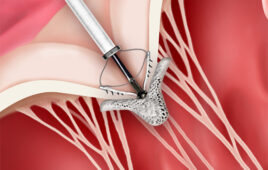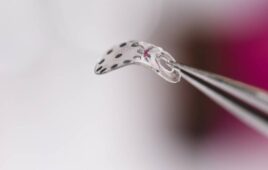 The medical device industry is constantly changing. New technologies and products enter the market, replacing outdated or inefficient equipment. There are numerous benefits in using LEDs for medical illumination applications including longer life, less heat, dynamic control, lower energy consumption, and in many cases, lower cost. LED technology has improved significantly over the years, and is currently being integrated into medical devices, including surgical lighting, exam lights, phototherapy, and endoscopy.
The medical device industry is constantly changing. New technologies and products enter the market, replacing outdated or inefficient equipment. There are numerous benefits in using LEDs for medical illumination applications including longer life, less heat, dynamic control, lower energy consumption, and in many cases, lower cost. LED technology has improved significantly over the years, and is currently being integrated into medical devices, including surgical lighting, exam lights, phototherapy, and endoscopy.
The proliferation of LED technology within the medical space has coincided with substantial performance gains achieved during the past decade. Once viewed as simple on/off indicators, LEDs now have the power to displace most existing traditional lighting technologies. For the past 30 years, LEDs have followed Haitz’ law, named after former Agilent Technologies Engineer, Roland Haitz, which states that every 10 years the amount of light generated by an LED increases by a factor of 20, while the cost per lumen falls by a factor of 10 (Figure 1). This dramatic increase in performance and reduction in cost have made LED technology viable for even the most demanding lighting-based medical applications.
Exam room lighting and minor surgery lights, consisting of 50 to 100 W halogen lamp technology, were two of the early applications for LEDs. LEDs provided the benefits of longer life and less heat in the beam. Major overhead surgical lighting has experienced a transformation in performance and style as a result of adopting LED technology. The traditional single source deep reflector bowl has been replaced by a multiplicity of direct view LEDs in a fixture with a significantly thinner profile. Multiple sources in the LED light help prevent shadowing at the surgical site when obstructed by a surgeon’s head. Vastly reduced heat content in the beam makes for a more comfortable working environment for the surgeon and presents lower risk of tissue damage to the patient. Today, LED technology can achieve the very challenging performance specifications for a top-of-the-line major overhead surgical light, including 160,000 lux on target with CRI greater than 95 and R9 in excess of 90. Another novel advantage of LED technology in an overhead surgical light is ability to dynamically change the color properties of the light. For example, the color of the light could be changed on the fly via voice command from a 6,500K cool white to a more neutral 4,000K, depending on surgeon preference. This type of flexibility and control is simply not possible with conventional tungsten halogen lighting technology.
 High intensity discharge lamps, such as xenon, are ubiquitous within the field of endoscopy for minimally invasive surgery and diagnosis. During an endoscopic procedure, surgical instruments are typically inserted into the body through a small incision. The area of interest within the body is illuminated using a small diameter fiber bundle that is inserted along with the surgical tools. Coupling light into a small diameter fiber bundle is difficult, so an extremely bright light source is required. Historically, the light source of choice has been the 180 to 300 W xenon lamp, which could deliver 1,000+ lumens of light at the distal end of the fiber bundle. While xenon is able to achieve the technical requirements for endoscopy, it has a very short life—about 1,000 hours—and is expensive.
High intensity discharge lamps, such as xenon, are ubiquitous within the field of endoscopy for minimally invasive surgery and diagnosis. During an endoscopic procedure, surgical instruments are typically inserted into the body through a small incision. The area of interest within the body is illuminated using a small diameter fiber bundle that is inserted along with the surgical tools. Coupling light into a small diameter fiber bundle is difficult, so an extremely bright light source is required. Historically, the light source of choice has been the 180 to 300 W xenon lamp, which could deliver 1,000+ lumens of light at the distal end of the fiber bundle. While xenon is able to achieve the technical requirements for endoscopy, it has a very short life—about 1,000 hours—and is expensive.
Luminus Devices has designed a line of high performance LEDs optimized to displace xenon technology for endoscopy. There are two critical design aspects in developing an LED for endoscopy. First, the LED must be able to generate lumen density in excess of 300 lumens/mm2 over an area of about 8 mm2. Luminus has achieved this through innovative manufacturing and packaging technologies that allow the chip to be driven at a very high current density of 2 A/mm2.
The second challenge for this application is getting the photons from the surface of the LED chip into the fiber bundle. Luminus developed a suite of technologies for its LEDs to optimize the photon transfer into the fiber. The Luminus LED emits directly into air instead of being encapsulated in a silicone material like nearly every other LED on the market. Emitting into air reduces the optical extent (etendue) of the source, and preserves the system etendue as defined by the standard 5mm diameter fiber used in many endoscopic procedures.
 In 2012, Luminus released the world’s first round emitting LED chip. Here, maximum efficiency is achieved by optically coupling a round source to the round input face of the fiber bundle. Non-imaging optics such as compound parabolic concentrators (CPCs) or optical tapers are typically used to transfer the light from the LED to the fiber. For reasons of manufacturability and cost, these optics are usually symmetric—meaning they consist of square input and output faces, or they consist of round input and output faces. To avoid optical loss due to a square mating with a circle, the highest efficiency solution is a round LED, round coupling optic and round fiber bundle. The traditional approach of using a square LED and overfilling the input aperture of the optic results in lost photons, while under-filling the optic results in a “missed opportunity” to inject more light into the fiber. The round LED optimizes the geometry and efficiency of the endoscopy optical train from end to end. Luminus has already enabled its endoscopy customers to displace the 180W xenon lamp with its LEDs, and with the advent of round LEDs and a few other advances, the golden standard 300W xenon lamp is next in line to be displaced.
In 2012, Luminus released the world’s first round emitting LED chip. Here, maximum efficiency is achieved by optically coupling a round source to the round input face of the fiber bundle. Non-imaging optics such as compound parabolic concentrators (CPCs) or optical tapers are typically used to transfer the light from the LED to the fiber. For reasons of manufacturability and cost, these optics are usually symmetric—meaning they consist of square input and output faces, or they consist of round input and output faces. To avoid optical loss due to a square mating with a circle, the highest efficiency solution is a round LED, round coupling optic and round fiber bundle. The traditional approach of using a square LED and overfilling the input aperture of the optic results in lost photons, while under-filling the optic results in a “missed opportunity” to inject more light into the fiber. The round LED optimizes the geometry and efficiency of the endoscopy optical train from end to end. Luminus has already enabled its endoscopy customers to displace the 180W xenon lamp with its LEDs, and with the advent of round LEDs and a few other advances, the golden standard 300W xenon lamp is next in line to be displaced.
 Luminus LEDs are also utilized in light guided systems for phototherapy. In particular, Luminus is supplying the solid-state source for several bilirubin lights being released to the market. These new “bili lights” shine a bluish light on newborn babies skin to combat excess buildup of bilirubin in the blood, which can lead to jaundice and ultimately brain damage if left untreated. The blue LED light breaks down bilirubin to make it water soluble so that it can be excreted by the baby.
Luminus LEDs are also utilized in light guided systems for phototherapy. In particular, Luminus is supplying the solid-state source for several bilirubin lights being released to the market. These new “bili lights” shine a bluish light on newborn babies skin to combat excess buildup of bilirubin in the blood, which can lead to jaundice and ultimately brain damage if left untreated. The blue LED light breaks down bilirubin to make it water soluble so that it can be excreted by the baby.
Another medical application benefiting from round LEDs is surgical headlights. The optical system of surgical headlight typically consists of a high intensity beam of light with a narrow divergence angle. Narrow beam systems often reimage the source geometry onto the target, so a square LED would look like a square beam of light at the patient site. The benefit of a round LED for surgical headlights, is that it creates a circular beam illumination field on the patient without brightness penalties associated with with the use of faceting or diffusion.
As a new technology in the field of medical illumination, LEDs are judged by their performance against incumbent technologies. Performance requirements are often demanding as medical devices typically utilize the highest performance light sources available for the application. Luminus has experienced success in medical illumination by optimizing its LEDs for specific applications. Specific examples include LEDs that are round and can be driven at extremely high current density.
Ongoing advancements in LEDs that are driving the technology’s use in medical devices include improvement in light intensity, product size and weight; long-term reliability, and heat/temperature management, and with continued improvements we will likely continue to see new solutions and increased adoption of the technology.




